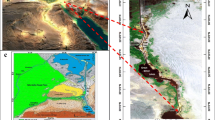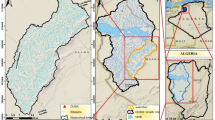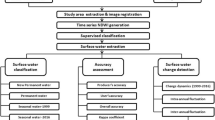Abstract
Satellite imagesare usedto extract and calculate surface water area and water resource features accurately. Water index and optimum threshold methods are essential for the extraction of surface water area. Various water indices have been developed during the past two decades, such as Normalized difference water index (NDWI), Modified normalized difference water index, Automated Water Extraction Index for shadow and non-shadow, Water Ration Index (WRI) and Normalized difference vegetation index. With application of each of these indices, the surface water area can be extracted by applying the respective threshold values for the indices and computed areas. The present study focuses on the comparing the accuracy of surface water area extraction for respective water indices and obtaining an optimal threshold value to separate water and other features from output images of indices using a Semi-automatic double-window flexible pace search (DFPS) method. The surface water areas of the Kaylana Lake (at Jodhpur, Rajasthan, India)have been extracted for different years with above stated indices and further compared with the extracted values by applying the polygon method on historical images received from Google Earth. The extracted surface water areas with polygon method on historical Google Earth images are 0.88 km2, 0.74 km2, 1.22 km2, 0.67 km2and 1.00 km2for the years 2002, 2008, 2010, 2015, 2019 respectively. The comparison of extracted output results using different indices clearly indicates that the Semi-Automatic DFPS method is the best method to obtain optimum threshold value and to classified water indices output. The final comparison of outputs of indices also shows that overall NDWI provided much better surface water area output results. This study method identifies water bodies using Landsat TM, Lansat ETM + , Landsat OLI, and Sentinel-2A imagery with high accuracy by using NDWI water index and DFPS optimum threshold calculation method.

Source Survey of India









Similar content being viewed by others
Abbreviations
- DFPS:
-
Double windows flexible pace search method
- NDWI:
-
Normalized difference water indices
- MNDWI:
-
Modified normalized difference water indices
- WRI:
-
Water ratio index
- NDVI:
-
Normalized difference water indice
- AWEI_sh:
-
Automated water extraction indices with shadow
- AWEI_nsh:
-
Automated water extraction indices with non_shadow
- TM:
-
Thematic mapper
- ETM + :
-
Enhanced thematic mapper
- OLI:
-
Operational land imager
References
Huang, W., DeVries, B., Huang, C., Lang, M., Jones, J., Creed, I., & Carroll, M. (2018). Automated extraction of surface water extent from sentinel-1 data. Remote Sensing, 10(5), 797. https://doi.org/10.3390/rs10050797
Tang, H., Lu, S., Ali Baig, M. H., Li, M., Fang, C., & Wang, Y. (2022). Large-scale surface water mapping based on landsat and sentinel-1 images. Water, 14(9), 1454. https://doi.org/10.3390/w14091454
Frazier, P. S., & Page, K. J. (2000). Water body detection and delineation with landsat TM data. Photogrammetric Engineering and Remote Sensing, 66, 1461–1468.
Gens, R. (2010). Remote sensing of coastlines: Detection, extraction, and monitoring. International Journal of Remote Sensing, 31, 1819–1836. https://doi.org/10.1080/01431160902926673
Lasko, K., Maloney, M. C., Becker, S. J., Griffin, A. W., Lyon, S. L., & Griffin, S. P. (2021). Automated training data generation from spectral indexes for mapping surface water extent with sentinel-2 satellite imagery at 10 m and 20 m resolutions. Remote Sensing, 13(22), 4531. https://doi.org/10.3390/rs13224531
Xu, H. (2006). Modification of normalized difference water index (NDWI) to enhance open water features in remotely sensed imagery. International Journal of Remote Sensing, 27(14), 3025–3033. https://doi.org/10.1080/01431160600589179
Qiao, C., Luo, J., Sheng, Y., Shen, Z., Zhu, Z., & Ming, D. (2012). An adaptive water extraction method from remote sensing image based on NDWI. Journal of the Indian Society of Remote Sensing, 40, 421–433. https://doi.org/10.1007/s12524-011-0162-7
Otukei, J. R., & Blaschke, T. (2010). Land cover change assessment using decision trees, support vector machines and maximum likelihood classification algorithms. International Journal of Applied Earth Observation and Geoinformation, 12, S27–S31. https://doi.org/10.1016/j.jag.2009.11.002
Pal, M. (2005). Random forest classifier for remote sensing classification. International Journal of Remote Sensing, 26(1), 217–222. https://doi.org/10.1080/01431160412331269698
Zhang, C., Sargent, I., Pan, X., Li, H., Gardiner, A., Hare, J., & Atkinson, P. M. (2019). Joint deep learning for land cover and land use classification. Remote Sensing of Environment, 221, 173–187. https://doi.org/10.1016/j.rse.2018.11.014
Ghosh, M. K., Kumar, L., & Roy, C. (2015). Monitoring the coastline change of Hatiya Island in Bangladesh using remote sensing techniques. ISPRS Journal of Photogrammetry and Remote Sensing, 101, 137–144. https://doi.org/10.1016/j.isprsjprs.2014.12.009
Li, L., Yan, Z., Shen, Q., Cheng, G., Gao, L., & Zhang, B. (2019). Water body extraction from very high spatial resolution remote sensing data based on fully convolutional networks. Remote Sensing, 11(10), 1162. https://doi.org/10.3390/rs11101162
Yang, Z., Ghadamyari, M., Khorramdel, H., Alizadeh, S. M. S., Pirouzi, S., Milani, M., Ghadimi, N., et al. (2021). Robust multi-objective optimal design of islanded hybrid system with renewable and diesel sources/stationary and mobile energy storage systems. Renewable and Sustainable Energy Reviews, 148, 111295. https://doi.org/10.1016/j.rser.2021.111295
Dehghani, M., Ghiasi, M., Niknam, T., Kavousi-Fard, A., Shasadeghi, M., Ghadimi, N., & Taghizadeh-Hesary, F. (2020). Blockchain-based securing of data exchange in a power transmission system considering congestion management and social welfare. Sustainability, 13(1), 90. https://doi.org/10.3390/su13010090
Mehrpooya, M., Ghadimi, N., Marefati, M., & Ghorbanian, S. A. (2021). Numerical investigation of a new combined energy system includes parabolic dish solar collector, Stirling engine and thermoelectric device. International Journal of Energy Research, 45(11), 16436–16455. https://doi.org/10.1002/er.6891
Xu, Z., Sheykhahmad, F. R., Ghadimi, N., & Razmjooy, N. (2020). Computer-aided diagnosis of skin cancer based on soft computing techniques. Open Medicine, 15(1), 860–871.
Du, Y., Zhang, Y., Ling, F., Wang, Q., Li, W., & Li, X. (2016). Water bodies’ mapping from sentinel-2 imagery with modified normalized difference water index at 10-m spatial resolution produced by sharpening the SWIR Band. Remote Sensing, 8(4), 354. https://doi.org/10.3390/rs8040354
Jiang, W., He, G., Pang, Z., Guo, H., Long, T., & Ni, Y. (2020). Surface water map of China for 2015 (SWMC-2015) derived from Landsat 8 satellite imagery. Remote Sensing Letters, 11(3), 265–273. https://doi.org/10.1080/2150704X.2019.1708501
Skakun, S., Vermote, E. F., Artigas, A. E. S., Rountree, W. H., & Roger, J. C. (2020). An experimental sky-image-derived cloud validation dataset for Sentinel-2 and Landsat 8 satellites over NASA GSFC. International Journal of Applied Earth Observation and Geoinformation, 95, 102253. https://doi.org/10.1016/j.jag.2020.102253
Ssekyanzi, A., Nevejan, N., Van der Zande, D., Brown, M. E., & Van Stappen, G. (2021). Identification of potential surface water resources for inland aquaculture from sentinel-2 images of the rwenzori region of Uganda. Water, 13(19), 2657. https://doi.org/10.3390/w13192657
Alesheikh, A. A., Ghorbanali, A., & Nouri, N. (2007). Coastline change detection using remote sensing. International Journal of Environmental Science and Technology, 4, 61–66. https://doi.org/10.1007/BF03325962
McFeeters, S. K. (1996). The use of the normalized difference water index (NDWI) in the delineation of open water features. International Journal of Remote Sensing, 17(7), 1425–1432. https://doi.org/10.1080/01431169608948714
Ning, F. S., & Lee, Y. C. (2021). Combining spectral water indices and mathematical morphology to evaluate surface water extraction in Taiwan. Water, 13(19), 2774. https://doi.org/10.3390/w13192774
Guo, Q., Wu, X., Sang, X., Fu, Y., Zang, Y., & Gong, X. (2020). An integrated study on change detection and environment evaluation of surface water. Applied Water Science, 10(1), 1–15. https://doi.org/10.1007/s13201-019-1109-3
Feyisa, G. L., Meilby, H., Fensholt, R., & Proud, S. R. (2014). Automated water extraction index: A new technique for surface water mapping using Landsat imagery. Remote Sensing of Environment, 140, 23–35. https://doi.org/10.1016/j.rse.2013.08.029
Zhai, K., Wu, X., Qin, Y., & Du, P. (2015). Comparison of surface water extraction performances of different classic water indices using OLI and TM imageries in different situations. Geo-Spatial Information Science, 18(1), 32–42. https://doi.org/10.1080/10095020.2015.1017911
Piyoosh, A. K., & Ghosh, S. K. (2017). Semi-automatic mapping of anthropogenic impervious surfaces in an urban/suburban area using Landsat 8 satellite data. GIScience & Remote Sensing, 2017, 1–24. https://doi.org/10.1080/15481603.2017.1282414
Verma, P., & Kumar Ghosh, S. (2019). Classification of glacial lakes using an integrated approach of DFPS technique and gradient analysis using Sentinel 2A data. Geocarto International, 34(10), 1075–1088. https://doi.org/10.1080/10106049.2018.1469677
Wang, Y., Lv, H., Deng, R., & Zhuang, S. (2020). A comprehensive survey of optical remote sensing image segmentation methods. Canadian Journal of Remote Sensing. https://doi.org/10.1080/07038992.2020.1805729
Rokni, K., Ahmad, A., Selamat, A., & Hazini, S. (2014). Water feature extraction and change detection using multitemporal Landsat imagery. Remote sensing, 6(5), 4173–4189. https://doi.org/10.3390/rs6054173
Gao, H., Wang, L., Jing, L., & Xu, J. (2016). An effective modified water extraction method for Landsat-8 OLI imagery of mountainous plateau regions. In IOP conference series: earth and environmental science (Vol. 34, No. 1, p. 012010). IOP Publishing. https://doi.org/10.1088/1755-1315/34/1/012010
Guo, Q., Pu, R., Li, J., & Cheng, J. (2017). A weighted normalized difference water index for water extraction using Landsat imagery. International Journal of Remote Sensing, 38(19), 5430–5445. https://doi.org/10.1080/01431161.2017.1341667
Zhou, Y., Dong, J., Xiao, X., Xiao, T., Yang, Z., Zhao, G., & Qin, Y. (2017). Open surface water mapping algorithms: A comparison of water-related spectral indices and sensors. Water, 9(4), 256. https://doi.org/10.3390/w9040256
Wang, Y., Li, X., Zhou, P., Jiang, L., & Du, Y. (2022). AHSWFM: Automated and hierarchical surface water fraction mapping for small water bodies using sentinel-2 images. Remote Sensing, 14(7), 1615. https://doi.org/10.3390/rs14071615
Cui, Y., Yan, Z., Wang, J., Hao, S., & Liu, Y. (2022). Deep learning–based remote sensing estimation of water transparency in shallow lakes by combining Landsat 8 and Sentinel 2 images. Environmental Science and Pollution Research, 29(3), 4401–4413.
Islam, K., Jashimuddin, M., Nath, B., & Nath, T. K. (2018). Land use classification and change detection by using multi-temporal remotely sensed imagery: The case of Chunati wildlife sanctuary, Bangladesh. The Egyptian Journal of Remote Sensing and Space Science, 21(1), 37–47. https://doi.org/10.1016/j.ejrs.2016.12.005
Acharya, T., Subedi, A., & Lee, D. (2018). Evaluation of water indices for surface water extraction in a landsat 8 scene of Nepal. Sensors, 18(8), 2580. https://doi.org/10.3390/s18082580
Nandi, D., Chowdhury, R., Mohapatra, J., Mohanta, K., & Ray, D. (2018). Automatic delineation of water bodies using multiple spectral indices. Themed Section: Engineering and Technology, 4(4), 498–512.
Arreola-Esquivel, M., Delgadillo-Herrera, M., Toxqui-Quitl, C., & Padilla-Vivanco, A. (2019). Index-based methods for water body extraction in satellite data. In Applications of digital image processing XLII (Vol. 11137, p. 111372N). International Society for Optics and Photonics. https://doi.org/10.1117/12.2529756
Parihar, S. K., Borana, S. L., & Yadav, S. K. (2019). Comparative evaluation of spectral indices and sensors for mapping of urban surface water bodies in jodhpur area: Smart & sustainable growth. In 2019 international conference on computing, communication, and intelligent systems (ICCCIS) (pp. 484–489). IEEE. https://doi.org/10.1109/ICCCIS48478.2019.8974505
Mukherjee, J., Mukherjee, J., & Chakravarty, D. (2019). Automated seasonal separation of mine and non mine water bodies from landsat 8 OLI/TIRS using clay mineral and iron oxide ratio. IEEE Journal of Selected Topics in Applied Earth Observations and Remote Sensing. https://doi.org/10.1109/JSTARS.2019.2895385
Wang, J., Ding, J., Li, G., Liang, J., Yu, D., Aishan, T., & Liu, J. (2019). Dynamic detection of water surface area of Ebinur Lake using multi-source satellite data (Landsat and Sentinel-1A) and its responses to changing environment. CATENA, 177, 189–201. https://doi.org/10.1016/j.catena.2019.02.020
Wang, X., Ling, F., Yao, H., Liu, Y., & Xu, S. (2019). unsupervised sub-pixel water body mapping with sentinel-3 OLCI image. Remote Sensing, 11(3), 327. https://doi.org/10.3390/rs11030327
Meng, L., Zhang, Z., Zhang, W., Ye, J., Wu, C., Chen, D., & Song, C. (2019). An automatic extraction method for lakes and reservoirs using satellite images. IEEE Access, 7, 62443–62456. https://doi.org/10.1109/ACCESS.2019.2916148
Nguyen, U. N., Pham, L. T., & Dang, T. D. (2019). An automatic water detection approach using landsat 8 OLI and google earth engine cloud computing to map lakes and reservoirs in New Zealand. Environmental monitoring and assessment, 191(4), 235. https://doi.org/10.1007/s10661-019-7355-x
Goffi, A., Stroppiana, D., Brivio, P. A., Bordogna, G., & Boschetti, M. (2020). Towards an automated approach to map flooded areas from Sentinel-2 MSI data and soft integration of water spectral features. International Journal of Applied Earth Observation and Geoinformation, 84, 101951. https://doi.org/10.1016/j.jag.2019.101951
Pena-Regueiro, J., Sebastiá-Frasquet, M. T., Estornell, J., & Aguilar-Maldonado, J. A. (2020). Sentinel-2 application to the surface characterization of small water bodies in Wetlands. Water, 12(5), 1487. https://doi.org/10.3390/w12051487
Yang, X., Chen, Y., & Wang, J. (2020). Combined use of sentinel-2 and landsat 8 to monitor water surface area dynamics using Google earth engine. Remote Sensing Letters, 11(7), 687–696. https://doi.org/10.1080/2150704X.2020.1757780
Shen, L., & Li, C. (2010). Water body extraction from landsat ETM+ Imagery using adaboost algorithm. In Proceedings of 18th international conference on geoinformatics, 18–20 June 2010, Beijing, China (pp. 1–4). https://doi.org/10.1109/Geoinformatics.2010.5567762
Rouse, J. W.; Haas, R. H.; Schell, J. A., & Deering, D. W. (1973). Monitoring vegetation systems in the great plains with ERTS (Earth Resources Technology Satellite). In Proceedings of third earth resources technology satellite symposium, Greenbelt, ON, Canada, 10–14 (Vol. SP-351, pp. 309–317).
Chen, J., Gong, P., He, C., Pu, R., & Shi, P. (2003). Land-use/land-cover change detection using improved change-vector analysis. PhotogrammEng Remote Sensing, 69(4), 369–379. https://doi.org/10.14358/PERS.69.4.369
Azzouzi, S. A., Vidal, A., & Bentounes, H. A. (2015). Enhancement of the double flexible pace search threshold determination for change vector analysis. The International Archives of Photogrammetry, Remote Sensing and Spatial Information Sciences, 40(7), 599. https://doi.org/10.5194/isprsarchives-XL-7-W3-599-2015
Shubho, M. T. H., Islam, S. R., Ayon, B. D., & Islam, I. (2015). An improved semi-automatic segmentation approach to land cover mapping for identification of land cover change and trend. International Journal of Environmental Science and Technology, 12(8), 2593–2602. https://doi.org/10.1007/s13762-014-0649-1
Li, J., & Roy, D. P. (2017). A global analysis of Sentinel-2a, Sentinel-2b, and Landsat-8 data revisit intervals and implications for terrestrial monitoring. Remote Sensing. https://doi.org/10.3390/rs9090902
Liu, L., Xiao, X., Qin, Y., Wang, J., Xu, X., Hu, Y., & Qiao, Z. (2020). Mapping cropping intensity in China using time-series Landsat and Sentinel-2 images and Google earth engine. Remote Sensing of Environment, 239, 111624. https://doi.org/10.1016/j.rse.2019.111624
Funding
All authors declared that they have no affiliations with or involvement in any organization or field with any financial or non-financial interest in the subject matter or materials discussed in this research study.
Author information
Authors and Affiliations
Corresponding author
Additional information
Publisher's Note
Springer Nature remains neutral with regard to jurisdictional claims in published maps and institutional affiliations.
Rights and permissions
Springer Nature or its licensor (e.g. a society or other partner) holds exclusive rights to this article under a publishing agreement with the author(s) or other rightsholder(s); author self-archiving of the accepted manuscript version of this article is solely governed by the terms of such publishing agreement and applicable law.
About this article
Cite this article
Choudhary, S.S., Ghosh, S.K. Surface Water Area Extraction by Using Water Indices and DFPS Method Applied to Satellites Data. Sens Imaging 23, 33 (2022). https://doi.org/10.1007/s11220-022-00403-4
Received:
Revised:
Accepted:
Published:
DOI: https://doi.org/10.1007/s11220-022-00403-4




